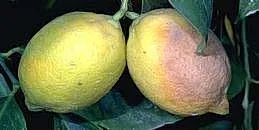
Cultural care can help in managing and spreading of the infection. It is important to reduce the sources. Remove fallen fruit from the ground as soon as it drops as well as remove damage fruit from the tree. To increase air circulation, prune out dead limbs and prune trees. Pruning tree skirts at least 24 inches above the ground will help to minimize the spores being splashed up from the ground. Do not allow sprinkler irrigation from wetting the fruit. Only harvest the fruit when the fruit is dry and do not store wet fruit - wet fruit becomes diseased during storage. Do not store infected fruit with clean fruit.
For serious problems applications of a preventive copper fungicide can be considered. This should be applied before or just after the first autumn rain, directing the spray to the ground beneath the tree and to the tree skirt up to 4 feet above the ground. When rainfall is extensive, additional applications in January or February would be beneficial.
Source: UCANR Publication 3332 Pests of the Garden and Small Farm pages 128-129
IPM Pest Information for brown rot

